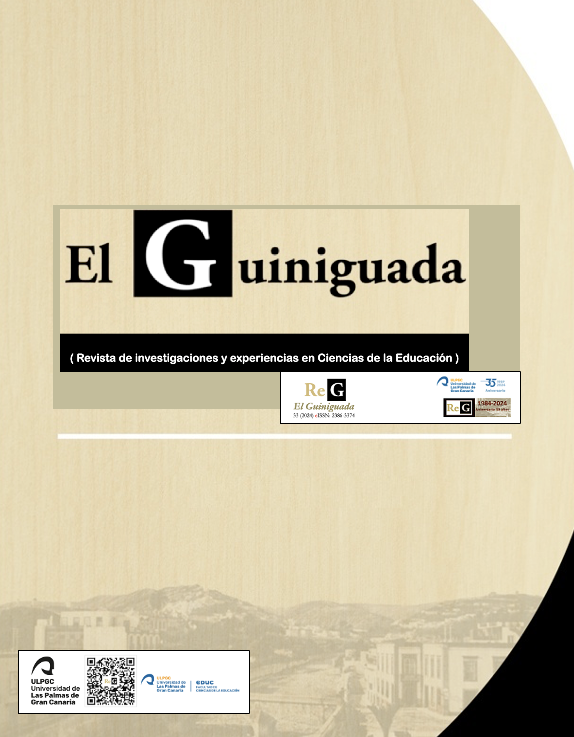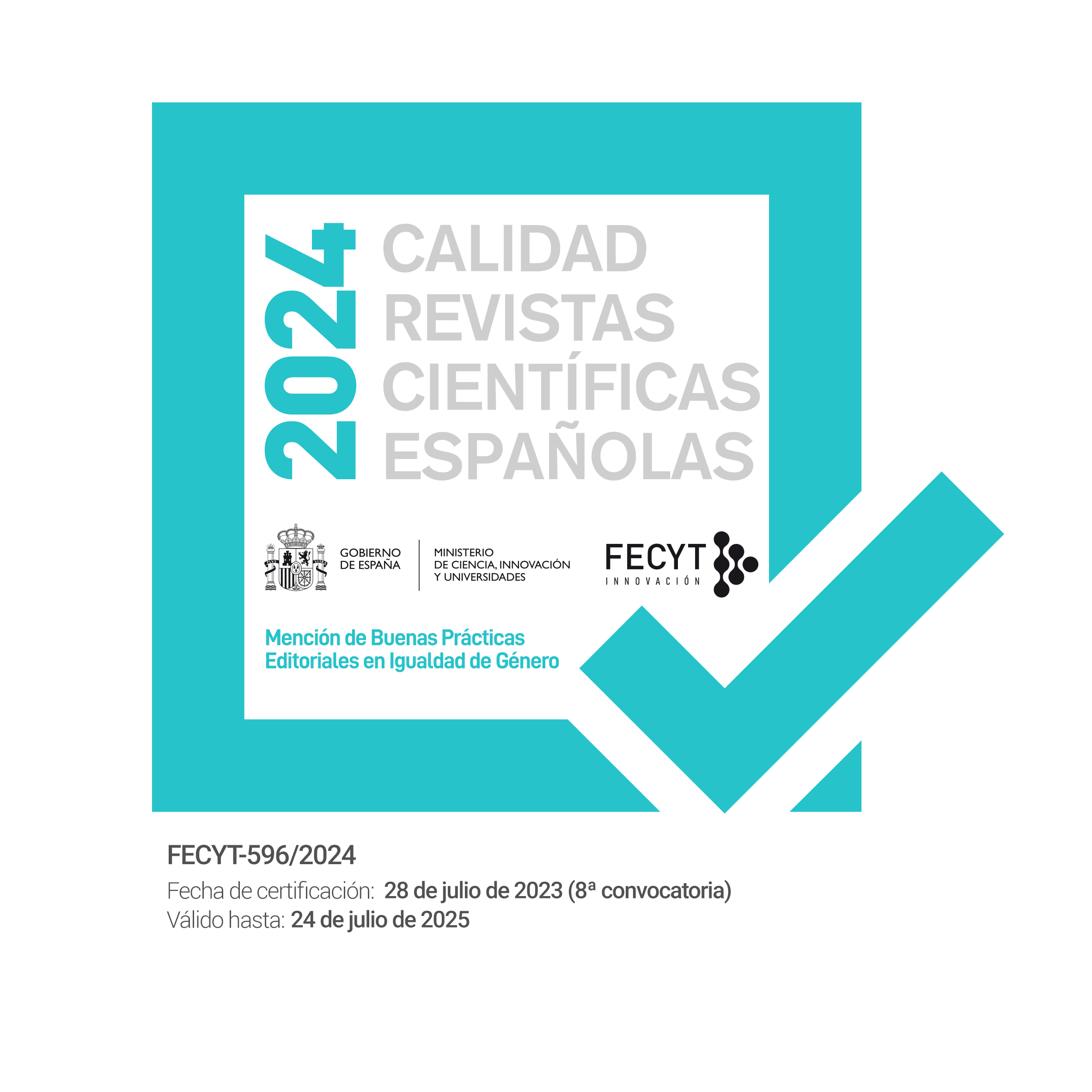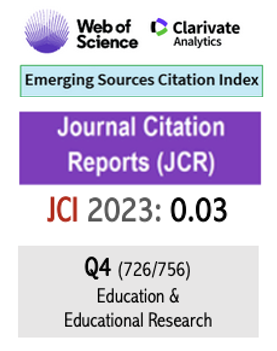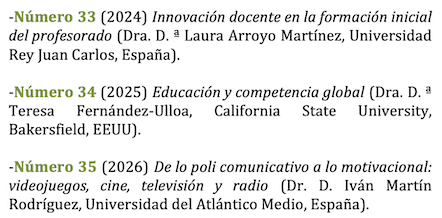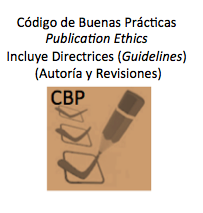Disfluencias del habla en estudiantes sinohablantes de español a partir del EEE-8. Speech Disfluencies in Spanish-speaking Students of Chinese Origin from the EEE-8
10.20420/ElGuiniguada.2024.721
Palabras clave:
DISFLUENCIAS DEL HABLA, ESTRATEGIA DE COMUNICACIÓN, ESTUDIANTES SINOHABLANTES, PAUSASResumen
En este estudio, se han escogido aleatoriamente 347 discursos de la prueba de traducción oral del Examen de Español como Especialidad realizado en China en 2019 con el propósito de analizar las disfluencias que cometen los estudiantes chinos que están a punto de graduarse en la carrera de Filología Hispánica. Se ha descubierto que las pausas sonoras representan la forma más frecuente (55,83 %), seguidas por las pausas silenciosas (15,18 %), la autocorrección fonética (9,57 %), la repetición parcial (8,54 %), la repetición completa (6,06 %) y la autocorrección léxica (4,82 %).
Descargas
Citas
Bortfeld, H., Leon, S. D., Brennan, S. E., Bloom, J. E., y Schober, M. F. (2001). Disfluency Rates in Conversation: Effects of Age, Relationship, Topic, Role, and Gender. Language and Speech 44, 123–147.
Cestero, A. M. (2000). El intercambio de turnos de habla en la conversación. Alcalá: Editorial Universidad de Alcalá. https://linred.web.uah.es/monograficos_pdf/LR_monografico14-articulo8.pdf
Chomsky, N. (1965). Aspects of the theory of syntax. Cambridge: MIT Press.
Clark, H. H. (1996). Using language. Cambridge: Cambridge University Press.
Clark, H. H., y Fox Tree, J. E. (2002). Using uh and um in spontaneous speech. Cognition 84, 73–111. https://www.sciencedirect.com/science/article/abs/pii/S0010027702000173
Corley, M., y Hartsuiker, R. J. (2011). Why um helps auditory word recognition: The temporal delay hypothesis. PLoS One 6(5), e19792. https://journals.plos.org/plosone/article?id=10.1371/journal.pone.0019792
Corley, M., y Stewart, O. W. (2008). Hesitation Disfluencies in Spontaneous Speech: The Meaning of um. Language and Linguistic Compass 2(4), 589–602. https://compass.onlinelibrary.wiley.com/doi/10.1111/j.1749-818X.2008.00068.x
Dai, Ch. (2011). A Study on Disfluency in Chinese to English Interpretations of Chinese EFL Learners. Shanghai Journal of Translation 1, 38–43.
Duan, M. (2020). Vowel frequencies in English and Chinese lexicons. Language Teaching and Linguistic Studies 202(2), 33–40.
Fox Tree, J. E. (1995). The Effects of False Starts and Repetitions on the Processing of Subsequent Words in Spontaneous Speech. Journal of Memory and Language 34, 709–738. https://www.sciencedirect.com/science/article/abs/pii/S0749596X85710327
Fraundorf, S. H., y Watson, D. G. (2014). Alice’s Adventures in Um-Derland: Psycholinguistic Sources of Variation in Disfluency Production. Language, Cognition and Neuroscience 29, 1083–1096. https://www.ncbi.nlm.nih.gov/pmc/articles/PMC4203439/
Gbadegesin, M. O. (2018). Hesitation as Gender Marker: A Discourse Intonation Approach. International Journal for Innovative Research in Multidisciplinary Field 4(10), 88–95. https://www.ijirmf.com/wp-content/uploads/201810014.pdf
Giannini, A. (2003). Hesitation Phenomena in Spontaneous Italian. Proceedings of the 15th International Congress of Phonetic Sciences, 2653–2656. https://www.internationalphoneticassociation.org/icphs-proceedings/ICPhS2003/papers/p15_2653.pdf
Gkalitsiou, Z., Byrd, C. T., Bedore, L. M., y Taliancich-Klinger, C. L. (2017). Stuttering on Function Words in Bilingual Children who Stutter: A Preliminary Study. Clinical Linguistics and Phonetics 31, 1–16. https://moody.utexas.edu/sites/default/files/Stuttering%20on%20function%20words%20in%20bilingual%20children_2017.pdf
Hartsuiker, R. J., Pickering, M. J., y De Jong, N. (2005). Semantic and phonological context effects in speech error repair. Journal of Experimental Psychology: Learning, Memory, and Cognition 31(5), 921–932. https://psycnet.apa.org/record/2005-13211-007
Hartsuiker, R. J., y Kolk, H. H. J. (2001). Error monitoring in speech production: A computational test of the perceptual loop theory. Cognitive Psychology 42, 113–157. https://www.sciencedirect.com/science/article/abs/pii/S0010028500907448
Kjellmer, G. (2003). Hesitation in defence of er and erm. English Studies 84(2), 170–198. https://www.tandfonline.com/doi/abs/10.1076/enst.84.2.170.14903
Kovac, M. M. (2016). Repetitions as a communication strategy: A case study. Studies in English Language Teaching 4(1), 87–103. http://www.scholink.org/ojs/index.php/selt/article/view/476
Levelt, W. J. M. (1989). Speaking: from intention to articulation. Cambridge: MIT Press.
Liu, Ch. (1999). A brief discussion on the differentiation of nasal sounds before and after vowels in Mandarin. Journal of Taizhou University 2, 93–94.
López-Ozieblo, R. (2015). Análisis de disfluencias y gestos en nativos españoles y en alumnos de español como lengua extranjera, tesis doctoral, Universidad de Málaga. https://riuma.uma.es/xmlui/handle/10630/11747
Ma, D. (2012). Study on the Taxonomy of Disfluencies in Oral Production. Foreign Languages and Their Teaching 4, 30–34.
Machuca, M. J., Llisterri, J., y Ríos, A. (2015). Las pausas sonoras y los alargamientos en español: un estudio preliminar. Normas. Revista de Estudios Lingüísticos Hispánicos 5, 81–96. https://ojs.uv.es/index.php/normas/article/view/6823/0
Nicholson, H., Eberhard, K., Scheutz, M. (2010). “um...i don’t see any”: the function of filled pauses and repairs. Proceedings of DiSS-LPSS Joint Workshop, 89–92. https://hrilab.tufts.edu/publications/nicholsonetal10diss.pdf
Qiao, Q. (2003). The evolution of nasal initials in Shanxi dialect. Journal of Shanxi University 4, 78–81.
Parra Reyes, D., y Grande Tolentino, P. I. (2019). Perfil de la fluidez del habla en niños de 8 y 9 años en Santa Anita. Alétheia 7, 45–52. https://revistas.unife.edu.pe/index.php/aletheia/article/view/2152
Pons Bordería, Salvador (dir.). Corpus Val.Es.Co 3.0. <http://www.valesco.es> [25/11/2023]
Richards, J. C., y Schmidt, R. (2010). Longman Dictionary of Language Teaching and Applied Linguistics (4.a ed.). London: Routledge.
Rojas Contreras, D., Román Montes de Oca, D., Quezada Gaponov, C., y Pino Castillo, J. (2020). Disfluencias típicas del habla en niños fluentes de Santiago de Chile. Revista Chilena de Fonoaudiología 19, 1–11. https://revfono.uchile.cl/index.php/RCDF/article/view/60194
Rühlemann, C., Bagoutdinov, A., y O’Donnell, M. (2011). Windows on the mind: Pauses in conversational narrative. International Journal of Corpus Linguistics 16(2), 198–232. https://www.uni-marburg.de/de/fb10/iaa/institut/personen/ruehlemann/pauses_in_narrative-_bct.pdf
Schegloff, E., Jefferson G., y Sacks, H. (1977). The Preference for Self- Correction in the Organization of Repair in Conversation. Language 53(2), 361–382. https://www.jstor.org/stable/413107
Stepanova, S. (2007). Some features of filled hesitation pauses in spontaneous Russian. Proceedings of ICPhS, 1325–1328. http://www.icphs2007.de/conference/Papers/1261/1261.pdf
Tottie, G. (2011). Uh and um as sociolinguistic markers in British English. The International Journal of Corpus Linguistics 16, 173–196.
Wang, X., y Jin, X. (2020). A Study of Non-fluent Filled Pause among Chinese L2 Learners. Journal of Northeast Normal University 304, 84–92.
Publicado
Cómo citar
Número
Sección
Licencia
Derechos de autor 2024 Yang Song

Esta obra está bajo una licencia internacional Creative Commons Atribución-NoComercial-SinDerivadas 4.0.
El Guiniguada se distribuye en abierto bajo una licencia Creative Commons Reconocimiento–NoComercial–SinObraDerivada 4.0 Internacional. Permite pues que los autores/as retengan, sin restricciones, los derechos de autoría así como los de publicación y difusión (esta última en una web personal o en un repositorio institucional). Igualmente, los artículos pueden ser descargables y compartirse siempre que se reconozca la autoría, que no se realicen cambios y que no se utilicen comercialmente (CC BY-NC-ND). En los números anteriores a 2020 los derechos de autor/a eran transferidos a la Revista, pero desde el Volumen 29 (2020) se aplica la política de derechos de autoría actual.
La Revista proporciona por tanto un acceso abierto inmediato a su contenido basado en el principio de que ofrecer al público un acceso libre a las investigaciones ayuda a un mayor intercambio global de conocimiento, de acuerdo con la definición BOAI de acceso abierto. Los autores/as no pagan por publicar en El Guiniguada.
El destinatario principal de esta publicación es la comunidad científica en general. No obstante, dado el interés social de los temas vinculados con la educación, El Guiniguada es consciente de la previsible proyección general que sus volúmenes puedan tener. Su acceso abierto permite, igualmente, el conocimiento libre y general de su contenido.
Quienes publiquen en esta revista aceptan pues los términos siguientes:
- Conservarán sus derechos de autoría y garantizarán a la revista el derecho de primera publicación de su obra, el cual estará simultáneamente sujeto a la Licencia de reconocimiento de Creative Commons que permite a terceros compartir la obra siempre que se indique su autoría y su primera publicación en esta revista. Asimismo, se indica que no se puede hacer un uso comercial de la obra; tampoco está permitido su uso derivado.
- Podrán adoptar otros acuerdos de licencia no exclusiva de distribución de la versión de la obra publicada (p. ej.: depositarla en un repositorio institucional o publicarla en un volumen monográfico) siempre que se indique la publicación inicial en esta revista.
- Podrán difundir su obra a través de Internet (p. ej.: en archivos telemáticos institucionales o en los perfiles académicos o profesionales de los autores...) antes y durante el proceso de envío, lo cual puede producir intercambios interesantes y aumentar las citas de la obra publicada. (Véase El efecto del acceso abierto).
Asimismo y de acuerdo con la política de acceso abierto BOAI, todo el contenido está disponible gratuitamente sin cargo para el usuario o su institución. Los usuarios pueden leer, descargar, copiar, distribuir, imprimir, buscar o vincular los textos completos de los artículos, o usarlos para cualquier otro propósito legal, sin solicitar permiso previo del equipo editorial o de la autoría.
